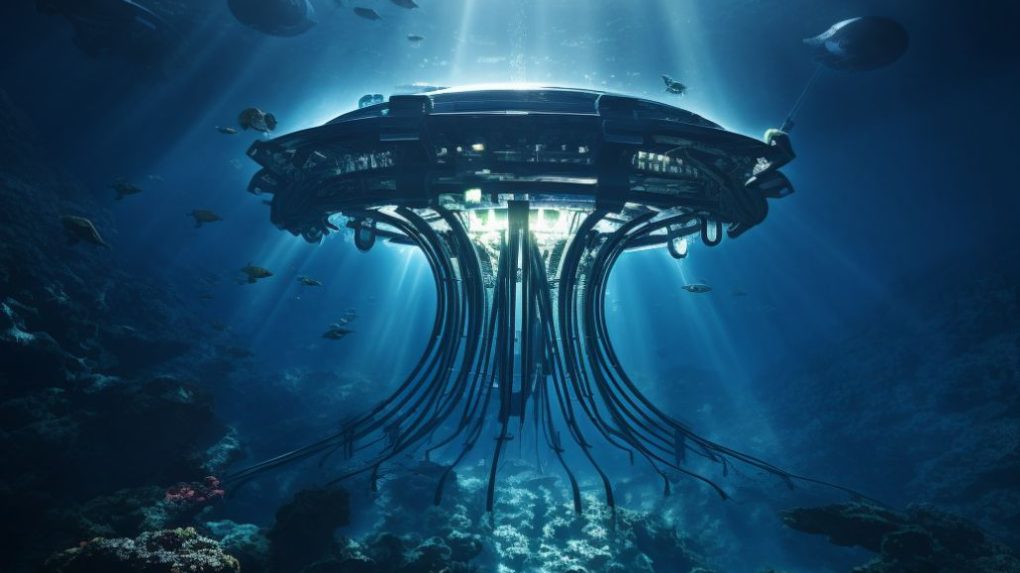The search for extraterrestrial life is one of science’s most exciting and challenging endeavors.
For years, scientists have focused their efforts on the hunt for life beyond Earth in outer space. But what if the answer has been right here on our planet? What if alien life exists not in the depths of the universe but in the depths of our oceans? This possibility has led researchers to dive deeper into the concept of aliens in the sea.
Defining Alien Oceans
When we think of oceans, we typically think of the vast bodies of water that cover more than 70% of the Earth’s surface. But what about seas on other planets? Researchers have recently discovered many ocean worlds within our solar system. Moons like Europa and Enceladus are believed to have subsurface oceans beneath their icy surfaces, while planets like Mars and Venus may have had oceans in the past.
While vastly different from Earth’s oceans, these alien oceans could be teeming with life. In fact, some scientists believe that the likelihood of finding extraterrestrial life in another planet’s ocean is much higher than finding it elsewhere in the universe.
Related: Aliens On Earth – Examining Stories Of An Alien Presence On This Planet
Exploring Earth’s Oceans
To understand the possibilities of alien oceans, we must first explore the vast and diverse oceans of our own planet. Despite covering over 70% of the Earth’s surface, we have only explored about 5% the total volume of the ocean floor. The Woods Hole Oceanographic Institution estimates that there are over a million undiscovered species living in the depths of our oceans.
One area of particular interest for scientists is hydrothermal vents. These hot spots on the ocean floor are home to various unique organisms that have evolved to survive in extreme conditions. Marine microbiology research suggests hydrothermal vents could be a model for life on other planets.
NASA’s Jet Propulsion Laboratory
NASA’s Jet Propulsion Laboratory (JPL) has been at the forefront of the search for alien life in the oceans of other planets. JPL has developed spacecraft and technology to explore the oceans of other worlds, including the Europa Clipper mission set to launch in 2024.
One of the key objectives of the Europa Clipper mission is to determine whether the subsurface ocean of Europa contains the right conditions to support life. The spacecraft will conduct a series of flybys to collect data and observations of the moon’s surface and atmosphere.
Signs of Alien Life
So what are scientists looking for when searching for signs of alien life in the ocean of another planet? Liquid water is a crucial ingredient for life as we know it, so the presence of water in any form is a good starting point. Scientists also look for evidence of organic molecules, which can signify life.
Another area of interest is hydrothermal vents. These hot spots on the ocean floor could provide the perfect environment for organisms living in the depths of an alien ocean. Professor Avi Loeb, Chair of Astronomy at the Harvard-Smithsonian Center for Astrophysics, believes hydrothermal vents could be home to alien technology.
Also read Exploring the World of Cryptids – An In-Depth Look at Legendary Creatures
The Hunt for Alien Life
The ongoing search for alien life is a collaborative effort among scientists worldwide. California’s Monterey Bay Aquarium Research Institute has been exploring the ocean’s depths and filming some of the most incredible creatures imaginable. Arctic researchers have discovered new species on the seafloor, while NASA scientists study the moons of Jupiter and Saturn for evidence of life.
But what happens if we do find evidence of extraterrestrial life? The discovery of life beyond Earth could have enormous implications for our understanding of the universe and our place within it. It could also lead to new possibilities for exploration and discovery.
Could an Alien Lifeform Exist in The Ocean? How Would We Detect Them?
Let’s embark on a speculative journey, envisioning what life and technology might be like for an alien species residing deep beneath our oceans, perhaps even below the seabed.
Environment: The oceanic climate is one of Earth’s harshest and most extreme. Perpetual darkness, bone-crushing pressures, near-freezing temperatures, and food scarcity characterize it. Assuming that these aliens are not just visiting but are adapted to live in this environment, they would be dealing with challenges similar to those faced by Earth’s deep-sea organisms, but potentially even more extreme if they live below the seafloor.
Technology for Survival: The technology a hypothetical alien species needs to survive in this environment would likely be highly advanced and specifically adapted to extreme conditions.
- Pressure resistance: The technology would need to withstand enormous pressures, which can exceed a thousand times the standard atmospheric pressure at sea level. This could involve highly durable materials or advanced engineering solutions that use external pressure to their advantage.
- Temperature regulation: Tools or structures would need to endure and possibly manipulate the cold temperatures to their advantage. They might harness geothermal energy from the Earth’s core, using the heat differential as an energy source.
- Nutrient extraction: They would likely need the means to obtain or produce food in this nutrient-poor environment. This might involve harvesting the sparse resources available or an advanced form of chemosynthesis, similar to how some deep-sea organisms use chemicals from hydrothermal vents to generate energy.
- Sensing and communication: In the pitch-black conditions of the deep sea, traditional visual sensing mechanisms would be ineffective. Thus, they might use other forms of perception, such as sonar-like echolocation or detection of chemical or electrical signals. Communication could also rely on non-visual signals, like those used by earthly marine mammals.
You may also like Life After Life: What Evidence Is There for an Afterlife?
Detecting Their Presence
Detecting an alien civilization deep beneath our oceans or under the seabed would be an enormous challenge, given our current technology. Here are some hypothetical ways we might achieve this:
- Advanced sonar technology: Given that sound travels well underwater, advanced sonar systems could potentially detect structures or activities related to an alien civilization. This would likely require significant advancements in our current sonar capabilities.
- Seismic detection: If they reside beneath the seabed, their activities might produce seismic waves that can be detected with sufficiently sensitive seismometers.
- Chemical traces: The activities of an alien civilization might leave chemical traces in the water, especially if they are using chemosynthesis. Advanced chemical sensors could potentially detect these anomalies.
- Thermal anomalies: If they’re using geothermal energy, this could create detectable thermal anomalies on the seafloor. Again, this would likely require significant advancements in our current sensing capabilities.
- Direct exploration: Lastly, we might need to physically explore the deep ocean and beneath the seabed more thoroughly. This would require substantial advancements in submarine technology and deep-sea exploration methods, given the challenging conditions of the deep sea.
Remember that all of this is purely speculative, based on the premise of an advanced alien civilization adapted to survive under conditions found deep within our oceans or under the seabed.
The Tic Tac Incident Off the Coast of California
The “Tic Tac” incident, officially known as the USS Nimitz UFO incident, is one of the most documented encounters between U.S. military pilots and an unidentified flying object. The incident occurred in November 2004, off the coast of Southern California, and the unidentified object was described as resembling a Tic Tac candy, hence the name.
The USS Nimitz Carrier Strike Group, which includes the aircraft carrier USS Nimitz and the guided missile cruiser USS Princeton, was conducting training exercises in the area. Over several days, the USS Princeton’s advanced radar systems began detecting unusual aerial objects moving in strange ways. These objects would descend from altitudes of approximately 80,000 feet to hover just above the ocean surface in a matter of seconds, demonstrating acceleration and maneuverability far beyond any known human technology.
On November 14, two FA-18F Super Hornet fighter jets from the USS Nimitz were redirected to investigate one of these objects. The pilots, Commander David Fravor and Lieutenant Commander Jim Slaight reported seeing an approximately 40-foot-long, white, oblong shape hovering above the water, making erratic movements. Fravor described the object as looking like a Tic Tac, moving in a way that he couldn’t explain: fast and without any predictable trajectory or pattern, seemingly defying the laws of physics.
Also read Exploring the World of Cryptids – An In-Depth Look at Legendary Creatures
As Commander Fravor descended to get a closer look, the object ascended toward his plane, then abruptly changed direction and accelerated away at high speed. Subsequently, another crew managed to capture video footage of one of these objects using an advanced targeting pod. The object in the video demonstrated similar erratic movement and high velocity, consistent with the earlier visual sighting.
Despite an informal investigation, the U.S. Navy could not identify the object. The incident remained relatively obscure until 2017, when the New York Times published a piece about the encounter, and the Department of Defense declassified and released the video footage. The Navy officially acknowledged the incidents and confirmed that the objects in the videos remain unidentified, bringing the event into the public spotlight and stirring up intrigue and debate about the possibility of extraterrestrial technology.
The Future of Alien Ocean Exploration
The search for aliens in the ocean is still in its early stages, but continued research and exploration could lead to even more exciting discoveries. As we explore a deeper dive into our own oceans, we may discover new clues about the origins of life on Earth and the possibilities for extraterrestrial life beyond our planet.
The possibility of aliens in the ocean is an exciting area of research that has the potential to change our understanding of life and the universe as a whole. While there is still much to learn and explore, scientists worldwide are working together to take a closer look at the oceans of other planets and the potential for extraterrestrial life.
As technology advances and research efforts expand, we may soon better understand the potential for life in our universe. The search for aliens in the ocean is just one piece of the puzzle, but it is an important one that could lead to groundbreaking discoveries.
Related: Aliens On Earth – Examining Stories Of An Alien Presence On This Planet
Conclusion
It’s important to note that the study of aliens in the ocean also comes with unique ethical considerations. As we explore and discover new worlds, it’s essential that we approach our efforts with care and consideration for the environment and any organisms that may be living there.
Overall, the search for aliens in the ocean is a fascinating and vital area of research that has the potential to reshape our understanding of life and the universe. Whether or not we find evidence of extraterrestrial life in our lifetime, this effort will undoubtedly lead to discoveries and advancements in science and technology.
Recommended Further Reading:
Auto Amazon Links: No products found.



